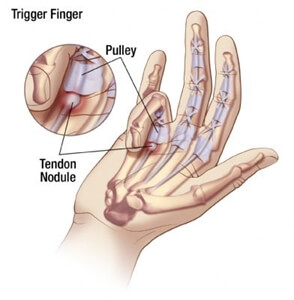
Nonsurgical Treatment of Trigger Finger
What is Trigger Finger?
Trigger finger, also known as stenosing tenosynovitis, is the locked finger disease. You won’t be able to correct the locked and strained finger and restore its normal form using your other hand. You may hear clattering noise when you try to correct the twisted finger. Apparent swelling is observed in fingers that cause pain and remain stiff and twisted. One or more fingers may be affected by the trigger finger. Little finger, ring finger, and thumb are the most common trigger finger areas and observed more frequently in the right hand.
What causes Trigger Finger?
Trigger finger disease has no explicitly recorded, distinct reason. Inflammation in the finger tendon or trauma due to swelled tendon sheath can trigger the disease.
Strong tissues that attach our muscles to the bones are called tendons. Tendons extending as part of the forearm muscles also attach our fingers to the bones. In short, the healthy movement of our fingers depends on the mobility of our tendons. And sheaths are elastic structures that contain tendons inside a tunnel-like structure. In normal movement, our tendons move comfortably inside the tendon sheaths, however, in the trigger finger, possible swelling of the region removes the required and expected elasticity and causes the finger to stuck in a rigid, trigger-like twisted position.
In which population is trigger finger most common?
Trigger fingers can occur in healthy people without any apparent cause. Trigger finger disease, which is especially observed in women older than 40 years of age, is observed to be common in 2 out of 100 people.
It is especially common in professions that require palm work or the use of machinery that requires palm pressure, such as a screwdriver. The inflammation caused by such use is known to cause trigger fingers.
In some cases, trigger fingers can occur as a side effect of another disease in people with rheumatoid arthritis, amyloidosis, diabetes, carpal tunnel syndrome, and dialysis patients. In addition to these, trigger fingers can also occur in people who have no disease or no occupational palm deformation.
Nonsurgical Treatment of Trigger Finger
One out of every five trigger finger cases tends to heal by itself without requiring surgical intervention. Some anti-inflammatory drugs can be used to assist the recovery. The splint or steroid treatment can be applied. However, our patients tell that they had all these mentioned recovery applications but failed to have results. With nonsurgical treatment of trigger finger, we perform an operation under local anesthesia that provides highly successful results. The Tendon sheath is extended through a single small incision and a thin needle. The tightly closed tunnel of the tendon sheath is attempted to be set free. Unlike surgical methods, the patient’s hand does not remain bandaged and non-functional for weeks; only the micro entry site is bandaged and the transition back to social life starts immediately.
- Category
- Body Woman

